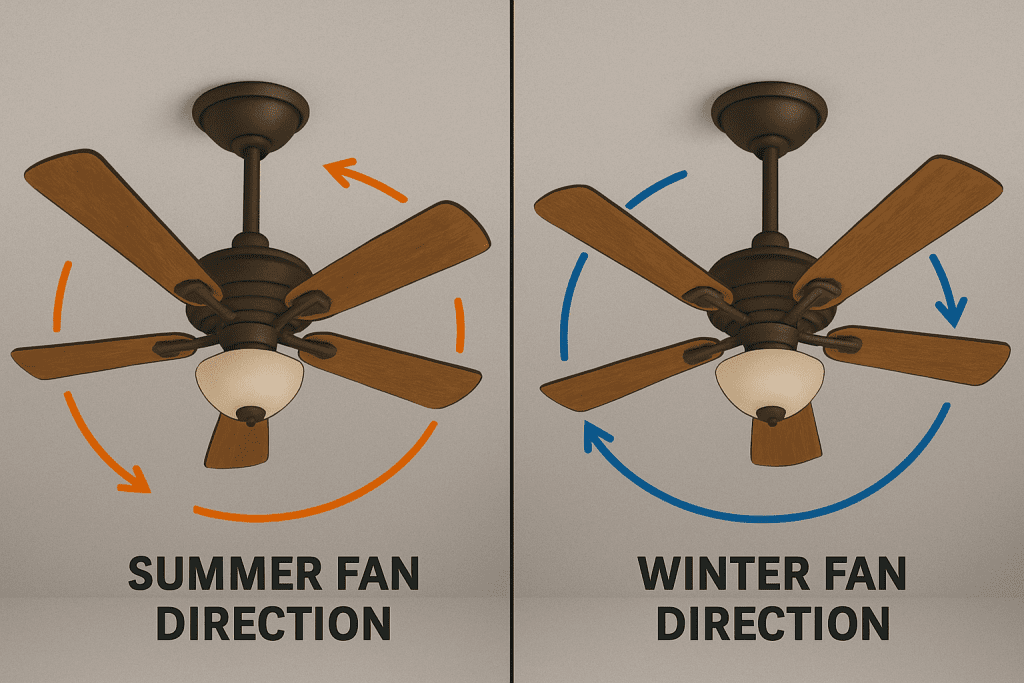Ceiling Fan Direction in the Winter: The Complete Guide to Staying Warmer & Saving Money
When the Cincinnati winter sets in, most homeowners focus on their furnace, but your ceiling fan is one of the simplest tools you can use to feel warmer and save energy. Yes, really! With the right fan direction, you can push warm air back down into your living spaces and help your home feel cozier without touching the thermostat.
Reversing your ceiling fan can:
-
Save up to 15% on heating costs
-
Let you lower your thermostat by 1–2 degrees
-
Reduce furnace runtime and wear
Which Way Should Your Fan Spin in the Winter?
In the winter, your fan should rotate clockwise at a low speed.
Most ceiling fans have a small toggle switch on the side of the motor housing. Flip it, and the direction changes. When it’s spinning clockwise, the fan pulls cool air upward, displacing the warm air gathered at the ceiling and gently pushing it down the walls and back into the room.
The key is low speed – you want air circulation, not a breeze. Top Tip: If you feel a breeze standing under your fan, it’s spinning the wrong way for winter. Feeling a breeze means your fan is in summer mode, meaning counterclockwise spinning.
Benefits of Running Your Fan in Winter
✔ More Comfort, Less Heat Loss
Redistributing warm air evens out temperature differences in your home, especially in rooms with high ceilings or open layouts.
✔ Lower Energy Bills
If your rooms feel warmer, you may be able to turn your thermostat down a degree or two – saving energy without sacrificing comfort.
✔ Reduced Strain on Your Furnace
Your heating system won’t have to work as hard to maintain your set temperature, which can help extend its lifespan.
Rooms Far From the Thermostat Benefit the Most
Thermostats only measure the temperature where they’re located, not in the cold corners of your home.
Running your fan in reverse helps:
-
Move warm air into distant or drafty rooms
-
Balance temperatures so the furnace doesn’t run endlessly
-
Fix cold bedrooms or basements without space heaters
Fans Work Differently in Homes With High or Vaulted Ceilings
If you have tall ceilings or a two-story living room, using your fan in the winter makes an even bigger difference.
Because warm air rises so far up, reversing the fan helps recover all that wasted heat. In very tall rooms, running the fan on medium (instead of low) helps distribute heat more effectively.
How to Change the Direction on Your Ceiling Fan
-
Turn off the fan.
Wait for the blades to come to a complete stop. -
Locate the direction switch.
It’s usually on the side of the fan housing. -
Flip the switch to change airflow direction.
-
Restart the fan at the lowest speed.
What If Your Ceiling Fan Uses a Remote?
If your ceiling fan is controlled by a remote, or through a wall-mounted control panel or smart home app, you may not see a physical switch on the fan at all. Many modern fans include a direction reversal button right on the remote. Look for labels like:
-
Reverse
-
Direction
-
Winter/Summer Mode
-
A small icon showing arrows circling in opposite directions
If you’re unsure, check the fan’s manual or look up the model number online. Using the remote makes switching directions quick and safe, with no need to climb up on a ladder.
When Is the Best Time to Run Your Fan in Winter?
You don’t need your ceiling fan running all day.
For maximum comfort and efficiency:
-
Run the fan while your furnace is running
-
Use a smart thermostat schedule to pair fan use with heating cycles
-
Turn it off at night if your bedroom cools too much
Some homes retain heat better when the fan is off overnight.
Don’t Forget to Switch It Back in Spring
When warm weather returns, reverse the direction again. In the summer, your ceiling fan should spin counterclockwise to create a cooling breeze.
Need Help Staying Warm This Winter?
A ceiling fan trick can make a big difference, but nothing replaces a well-maintained heating system. If your furnace is struggling to keep up, or you want to make sure it’s running at peak efficiency, our team at Quality Comfort Home Services is always here to help.
Whether it’s heating repair, maintenance, or indoor air comfort upgrades, we’re just a call or click away.




